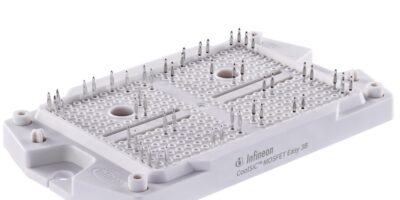CoolSiC M1H technology now includes 1200V SiC MOSFETs
Extending the CoolSiC technology portfolio, Infineon Technology has introduced the CoolSiC MOSFET 1200 V M1H. The SiC (silicon carbide) chip will be implemented in an extended portfolio using the Easy module family and discrete packages using .XT interconnect technology.
The M1H chip is suitable for solar energy systems, such as inverters, that have to meet peak demand. The chip is also suitable for fast EV charging and energy storage systems.
Advances in the CoolSiC base technology enable a larger gate operation window that improves the on-resistance for a given die size, explains Infineon. Simultaneously, the larger window provides robust performance against driver- and layout-related voltage peaks at the gate, without any restrictions even at higher switching frequencies, continues the company.
Infineon has also adopted housings with package variants to enable higher power densities and more options for design engineers.
The M1H will be integrated into the Easy 1B and 2B modules.
Infineon has also introduced the 1200V CoolSic MOSFET to enhance the Easy 3B module. With the M1H chip, the on-resistance of the modules can be significantly improved, says Infineon, making the devices more reliable and efficient than earlier models.
Maximum temporary junction temperature is 175 degrees C while overload capability has been increased, enabling higher power density and coverage of failure events. Compared to its predecessor (the M1) the M1H has implemented a small adoption of the internal R G, enabling the switching behaviour to be optimised. The dynamic behaviour is maintained with the M1H chip, continues Infineon.
The CoolSiC MOSFET 1200V M1H portfolio includes new low on-resistances 7.0, 14 and 20 mOhm in the TO247-3 and TO247-4 discrete packages. Gate voltage over-shoots and under-shoots facilitate design-in with the new maximum gate-source voltage down to -10V and avalanche and short-circuit capability specifications.
Infineon’s .XT interconnection technology, previously introduced in the D 2PAK-7L package, is now also implemented in a TO-footprint. The thermal dissipation capabilities are enhanced by more than 30 per cent compared to a standard interconnection, reports Infineon. Thermal benefit can therefore be used to increase the output power of up to 15 per cent. Alternatively, it can be used to increase the switching frequency to further reduce the passive components in, for example, electric vehicle (EV) charging, energy storage or photovoltaic systems. Without changing the system operating conditions, the .XT technology will lower the SiC MOSFET junction temperature, to increase the system lifetime and power cycling capabilities.
The module and discrete variants can be ordered now.




